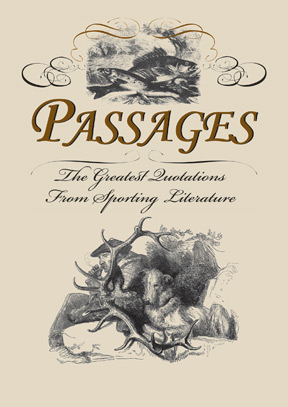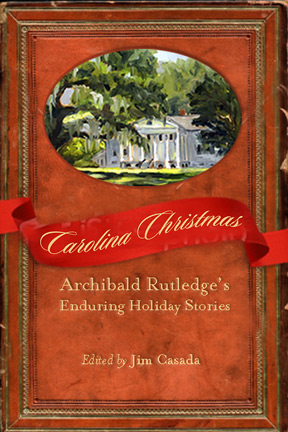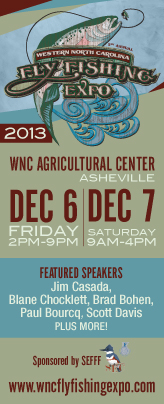|
November 2013 Newsletter
Click here to view this newsletter in a .pdf with a white background for easy printing.
This
Month's Quotations
|
|
Last month I spent a couple of days visiting my brother in our old home town, Bryson City, N.C., while attending a board meeting of the Southern Forest Watch. The group is one devoted to fighting the arbitrary, unreasonable fee imposed on backcountry campers in the Great Smoky Mountains National Park by the current superintendent, and as someone who cherishes the Park’s wild places as much as I detest government intrusion into every corner of our daily lives, I’ve been active in the struggle from the outset. While there, I happened to look out the den window and was amazed to see a ground hog grazing on the lawn. That simple sighting did two things—it pointed out to me just how much things have changed in the small town where I grew up over the course of my lifetime as well as taking me back to what has to be reckoned, all sorts of progress notwithstanding, to an era of what in many senses featured better days and better ways. It was a time when a boy could rush home from school, shuck off his jeans or overalls, don Duxbak britches and a coat made by the same company, stuff a couple of Red Delicious apples he had picked from the family orchard along the pathway leading to the house, and head off for serious dealings with bushytails. If his destination that day happened to take him through the heart of town, no one gave so much as a second glance to a youngster toting a gun. Mind you, if Lady Luck smiled down on him and he returned home in the gloaming with two or three artfully displayed squirrel tails hanging out of his game bag, he likely would garner a bit more attention and maybe even a comment or two to the effect: “Looks like there will be squirrel and dumplings on the Casada table tonight.” I might add that no groundhog would have had so much as a scintilla of a chance of surviving. I would have stalked it and sooner or later laid it low (and I might note that baked groundhog makes mighty fine table fare). Today Duxbak clothing belongs to a world we have lost, a victim of cheap Asian imports, an arguably misplaced fixation with camouflage as being de rigueur for any hunting activity, and changing sporting lifestyles. A boy toting a shotgun would get immediate police attention, create a panic, and if some kids were staying late after school, likely produce a lockdown. On top of that, you can’t shoot squirrels or groundhogs in the town limits of Bryson City (or pretty much any other small town); never mind that in my youth I killed scores of the former within a mile of the town square. Add to that the fact that a boy not yet in his teens hunting alone would send contemporary child psychologists into paroxysms of hand wringing and you begin to get the picture. Society, purportedly in the name of civilized advance and improvement, has robbed us of what was once the simplicity and innocence of small town and rural youth. In the 1960s my younger brother, as a teenager in school, drove a school bus and carried a gun along with him. So did several of my hunting buddies. That was so they could, once all their passengers had been delivered, stop at a likely spot along their routes and hunt squirrels until dusk. Today no one would think of letting a teenager have the responsibility of driving a bus, much less allowing him to tote a gun on it. Similarly, the very notion of stopping a bus for a spate of hunting, never mind that it didn’t put any extra mileage on the gauge and didn’t cost a red cent, would meet with sheer disbelief. Instead, we have youngsters coming home to computers, games played on screens rather than in the fields or woods, or mindless television programs. Or perhaps they “hang out” at a nearby mall, wander aimlessly along sidewalks, or drive their own car while getting up to who knows what kind of mischief. Robert Ruark had it right when he suggested that he never knew a boy who was serious about hunting and fishing who developed into a juvenile delinquent. They were too busy having meaningful fun. In my youth we didn’t have iPods, computers, cell phones, and other gadgets. The two electronic marvels in my boyhood home were a party-line telephone shared with three other families and a radio which was used only on special occasions such as listening to “The Lone Ranger,” “Amos and Andy,” or country music from WSM in Nashville or WCKY in Cincinnati. I didn’t own a car until I graduated from college, and the same was true of the vast majority of my friends. Driving was a distinct privilege, and it took something close to an act of Congress, in the form of the Junior-Senior Prom or maybe attendance at a special school function, to induce Daddy to let me “borrow the car.” Don’t get the idea that I had a deprived childhood, because such was distinctly and definitively not the case. I grew up in a world where close connection to nature was almost taken for granted and in a place where people genuinely cared for one another. Their caring was far removed from the politically driven, government-knows-best outlook associated with Hillary Clinton’s book, It Takes a Village: And Other Lessons Children Teach Us to Raise a Child and the perspective of most of today’s politicians, no matter what their political stripe. That line of thinking brings to mind two side notes. Basically, I think political stripe is the right description for politicians, because I connect stripes with skunks. As for Hillary, she didn’t write the book mentioned, a ghost writer did (and Hillary offered that individual no credit whatsoever). Even the central words in her title came from a book published a few years earlier by Jane Cowen-Fletcher. More to the point though, in the community where I grew up, rest assured the children didn’t do the teaching or provide moral compass. That duty rested squarely on the shoulders of their parents (and almost the only kids in single-parent families were those whose father had been killed in World War II), families, pastors, teachers, and the adult community at large. There wasn’t any welfare. SNAP cards (I think that’s the proper term for what used to be known as welfare stamps) didn’t exist. Poverty was widespread, but it was a burden all realized and did their part to alleviate. They just dealt with it. Even the poorest of families worked, and worked hard, and folks would no more have thought of going through a year without planting a garden and “putting away” everything they could in the way of foodstuffs than they would have objected to the simple joys of hunting and fishing. Everyone practiced the old mountain virtue, and it was one my parents often mentioned, of “making do with what you’ve got.” I realize I’ve trended off down a rabbit trail of political incorrectness here, but I’ll try to get back on the straight and narrow after sharing a few of what my Grandpa Joe would have called “gospel truths.” The people where I grew up would have been deeply ashamed of not working, and no job was too lowly, too unimportant, to be beneath a man’s dignity. Likewise, they didn’t want handouts, although let someone be down on their luck or going through a rough patch economically and you could rest assured that their neighbors helped out. Independence was a way of life, and that held true whether it came to the right to own a gun (every man I knew had one or two, and it was the dream of every boy to get his first gun), carry a knife (this was a matter of pride and practicality), or do things the way you saw fit. As long as you didn’t interfere with others, you lived your life pretty well as you pleased. |
Christmas Time’s A-Coming Although I’m quite possibly of regional if not national championship caliber when it comes to procrastination in connection with Christmas shopping, I can proudly proclaim I have already gotten one gift for my wife. It’s possible she’ll read this so I won’t say anything other than that it is a cookbook (I give her one every Christmas). Beyond that I rely in considerable measure on the instincts and insight of our daughter when it comes to holiday shopping within the family, and for my circle of sporting friends books are my old reliable standby.
On a personal level I never want much of anything, because I guess you could say in one sense that I’m an impulse shopper. That is, when I want something I get it if I can afford it. That said, I’m a minimalist when it comes to most things connected with hunting and fishing (although a fellow can never have too many guns or fly rods), so there’s not a lot to get for me other than books. Since no one in the family has a clue of what books I want and don’t have—my shelves are lined with thousands upon thousands of volumes—that’s pretty much a non-starter. I do recognize though that most folks aren’t like me, and as a reader, author, and bibliophile, let me humbly suggest that books make great Christmas gifts. I’ve got the first book I was ever given, now dating back over 60 years, and to me it’s still a treasure. The point is a simple one—books are gifts that endure and can be appreciated for decades. There are some I read annually and have done so for decades. Between those I have written and edited, cookbooks my wife and I have done jointly, and a whole host of out-of-print offerings, chances are you can find something suitable for family, friends, co-workers, hunt camp buddies, and the like on my Web site. Also, I’m more than happy to chat about possible choices on the phone (803-329-4354) or by e-mail. Take a look at the offerings on my Web site and see what strikes your gift-giving fancy. You can order by personal check or PayPal. One comment on the latter. Some of you have been perplexed when a specific item is not listed on the order form. However, near the bottom of the page there’s a place to enter other items. Just give the author and title of the book, along with the price, and it helps me if you indicate what list it comes from. Tel.: 803-329-4354 Upcoming Schedule November 7-9—Attending annual fall meeting of the South Carolina Outdoor Press Association. November 10-14—Sea duck hunting in Maine with Linda Powell of Mossberg and four fellow outdoor writers. Local DU folks will serve as our guides. December 6-7—Speaker (and I will have a booth as well) at the WNC Fly Fishing Expo in Asheville, N.C. December 9—Talk and book signing in Charleston, SC.
|
In my case, what a life it was, although full realization of that fact didn’t come until I was well along into adulthood. It involved freedom to roam the woods and wade trout streams from the time I was 11 or 12 years of age. It was the blessing of a father who patiently shared his love of hunting and fishing and gave me solid grounding in the ethos of sport. It was a mother who always had a word of praise for whatever I had caught or killed along with a magical ability to turn it into a delicious dish for the family table. It was a paternal grandmother who gave me free rein to raid the refrigerator, grab a cathead biscuit or fried pie whenever I wanted, or expect a stack cake on special occasions (she never disappointed me in that regard). It was Grandpa Joe, a down-to-earth eccentric who was really just a boy trapped in an old man’s body but blessed with the wisdom of having lived all his years closely attuned to earth’s rhythms. It was aunts and uncles, cousins and family friends, all of whom shared and cared, and in so doing blessed me beyond belief.
As I look fondly back on the Novembers of my boyhood, much of this comes back to me in wonderful, wistful fashion. Thoughts of the first week of rabbit season, which always fell in the week of Thanksgiving, take pride of place. By that juncture I had been hammering the bushytails hard for five or six weeks, and every survivor within walking distance of the house was nervous as a cat surrounded by rocking chairs in a room holding three large house dogs. It was time to listen to some beagle music and maybe strive to make some feathers fly (quail season opened at the same day as that for cottontails). Also, for a boy who had enough energy to make me wish that I now I still had some small portion of what once was mine in terms of get up and go, it was time for some brush busting and briar breaking rather than playing waiting game of still hunting which was my primary approach to squirrels.
My thoughts also harken back to family feasts on Thanksgiving, especially those when my paternal grandparents were still living. The day would feature an abbreviated rabbit hunt, winding up around 1 or 2 p.m., with a hurried cleaning up and changing of clothes before heading off to Grandpa Joe’s and Grandma Minnie’s house. There we’d join an assemblage of kinfolks comprised of three or four uncles and aunts, a passel of first cousins, some second cousins, and often as not a few family friends (usually widow ladies or old maids). The menfolk would gather in the living room, wisely leaving the kitchen and dining room to the womenfolks. Children would dash about in a wonderfully mad mess of merriment, outdoors if the weather was half decent but otherwise underfoot in the house.
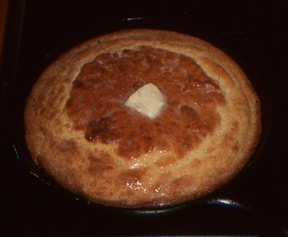 The feast, normally consumed around 3:30 or 4 p.m., was as sumptuous as
it was scrumptious. No one in our family even came close to being well
off, but there was always plenty of food and the family understood what
being thankful for a good year and a good harvest was all about. As a
rule we didn’t have turkey; instead, there would be three or four baked
hens which had gone off their laying duties and as a result paid the
supreme price. We likely would have cured ham as well, quite possibly
the first cutting from hams that had really not completed the curing
process (hog-killing time would have been three or four weeks earlier)
but just cried out for some sampling and a big schooner of red-eye
gravy. There would be cathead biscuits, cornbread and chestnut stuffing,
and cracklin’ cornbread in case you preferred that to biscuits; giblet
gravy for the dressing; enough pickles and relishes to hold the fort at
an all-day singing with dinner on the grounds (my favorites were peach
pickles and Grandma’s specialty, watermelon rind pickles); October
beans, green beans, and turnip greens with turnips diced up in them, all
cooked with plenty of streaked meat; cranberry relish made by my Aunt
Emma along with her ambrosia; creamed corn; piping hot Russian tea,
milk, and coffee for washing stuff down; sweet potato soufflé with
marshmallow topping; mashed Irish potatoes; and assorted other items
I’ve overlooked. Grandpa would say a simple blessing, always ending with
the same words: “You’uns see what’s before you. Eat hearty.”
The feast, normally consumed around 3:30 or 4 p.m., was as sumptuous as
it was scrumptious. No one in our family even came close to being well
off, but there was always plenty of food and the family understood what
being thankful for a good year and a good harvest was all about. As a
rule we didn’t have turkey; instead, there would be three or four baked
hens which had gone off their laying duties and as a result paid the
supreme price. We likely would have cured ham as well, quite possibly
the first cutting from hams that had really not completed the curing
process (hog-killing time would have been three or four weeks earlier)
but just cried out for some sampling and a big schooner of red-eye
gravy. There would be cathead biscuits, cornbread and chestnut stuffing,
and cracklin’ cornbread in case you preferred that to biscuits; giblet
gravy for the dressing; enough pickles and relishes to hold the fort at
an all-day singing with dinner on the grounds (my favorites were peach
pickles and Grandma’s specialty, watermelon rind pickles); October
beans, green beans, and turnip greens with turnips diced up in them, all
cooked with plenty of streaked meat; cranberry relish made by my Aunt
Emma along with her ambrosia; creamed corn; piping hot Russian tea,
milk, and coffee for washing stuff down; sweet potato soufflé with
marshmallow topping; mashed Irish potatoes; and assorted other items
I’ve overlooked. Grandpa would say a simple blessing, always ending with
the same words: “You’uns see what’s before you. Eat hearty.”
I took those final words to heart in precisely the spirit Grandpa tendered them. Yet no matter how much I ate, and let me assure you that as a youngster I was a trencherman gifted with about as voracious a tapeworm as is imaginable and with expansive stomach powers that would have been the envy of an anaconda, there was still plenty of room for dessert. It was family practice (and a wise one), to hold off on dessert for an hour or two after the meal. By that time, no matter how much I’d stored away earlier, yours truly would be a tad peckish for the sweet side of things.
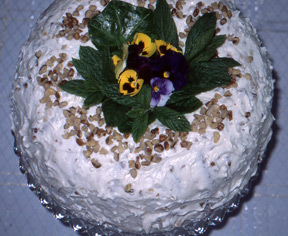 Oh those desserts! There would be pumpkin chiffon pie with real whipped
cream, not this frothy air in a pressurized can stuff you get today.
Grandma would have made a stack cake of at least seven layers, and the
filling, which varied yearly, might be dried apples or dried peaches
which had been stewed or maybe blackberry or dewberry preserves.
Whatever her choice for that year, she would have made the stack cake
far enough in advance for everything to have mixed, mingled, and married
into a toothsome wonder. Just thinking about her stack cakes still sets
my salivary glands into drooling overdrive.
Oh those desserts! There would be pumpkin chiffon pie with real whipped
cream, not this frothy air in a pressurized can stuff you get today.
Grandma would have made a stack cake of at least seven layers, and the
filling, which varied yearly, might be dried apples or dried peaches
which had been stewed or maybe blackberry or dewberry preserves.
Whatever her choice for that year, she would have made the stack cake
far enough in advance for everything to have mixed, mingled, and married
into a toothsome wonder. Just thinking about her stack cakes still sets
my salivary glands into drooling overdrive.
There would be an applesauce cake, stuffed with raisins and black walnut kernels, at least three kinds of pie and more likely four or five (apple, peach, pecan, buttermilk, lemon chess, and chocolate chess being among the more popular choices. For those who preferred to pour cream-laden milk over dessert, and I held a proud place in those ranks, there would also be at least one cobbler. Aunt Emma could be counted on for her signature orange-slice candy cake, and invariably Aunt Hildred came up with something no one had eaten before but which would be a real “dilly” (that was her nickname, and what a Dilly she was).
One treat she offered which I particularly remember was black walnut bars (see recipe below).
By this time of year we had always gathered a bunch of black walnuts, let the hulls dry, and the nuts were ready for cracking. However, that family effort usually waited until nearer Christmas, so the nuts used in the sticky, sweet treats were likely those still remaining from the previous year’s cracking work. Now I have a friend, Ken Roper, who makes a really handy walnut cracker, but in those days Daddy put them in a vise and closed its jaws until the nut broke open. If you’d like to know more about Ken’s cracker (he makes a few to sell), drop me an e-mail and I’ll put you in touch with him. Ken’s a fine son of the Smokies I’ve gotten to know in recent years, and like so many folks with mountain roots, he’s mighty handy with both his hands and ideas.
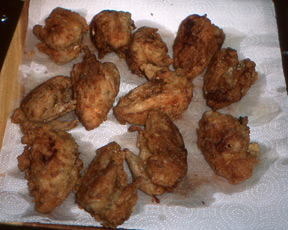 Leftovers would carry the day on Friday, but come Saturday evening or
perhaps dinner on Sunday, there would be another round of feasting. This
time the menu would be slimmer, in terms of variety, but otherwise just
as scrumptious. The featured dish would be fried rabbit, with milk gravy
and biscuits on the side, perhaps flanked by squirrel, maybe two or
three quail, and more rarely, a grouse. Served with sweet potatoes,
apple sauce Mom had canned from our little orchard, and a heaping dish
of green beans she had also canned, it was a fitting way to round out a
culinary celebration of a special time and the opening of a new portion
of hunting season.
Leftovers would carry the day on Friday, but come Saturday evening or
perhaps dinner on Sunday, there would be another round of feasting. This
time the menu would be slimmer, in terms of variety, but otherwise just
as scrumptious. The featured dish would be fried rabbit, with milk gravy
and biscuits on the side, perhaps flanked by squirrel, maybe two or
three quail, and more rarely, a grouse. Served with sweet potatoes,
apple sauce Mom had canned from our little orchard, and a heaping dish
of green beans she had also canned, it was a fitting way to round out a
culinary celebration of a special time and the opening of a new portion
of hunting season.
Those days are now long gone. My father was the last of nine children to die, at the age of 101. Well before that his siblings were deceased, their children dispersed, and Grandma and Grandpa gone to their permanent resting place high on a hill overlooking Deep Creek, with their grave sites (and those of my parents and several aunts and uncles) looking across the valley to another cemetery where three children in the family who died young were buried.
Chip and Dale, Lead and Lady, Queen and Tiny, and a whole bunch of other canine companions now chase cottontails where the season is always open, where they never once even think about backtracking, and where their hallelujah chorus rings along heavenly ridgelines. The same is true for the line of lanky, rib-showing pointers which belonged to my Uncle Hall.
For a generation though, those were truly the days - a time of November splendor, a gathering of a clan of simple mountain folks who knew the meaning of hard work, love of family, faith, and togetherness. Looking back, it’s no wonder November is for me a month of nostalgia. Time marches on, and I must confess that for all I enjoy Thanksgiving today, celebrated each year with our daughter and her family, it is a holiday even better enjoyed through longing looks backward. To me, that’s as it should be, for all the magic of childish delight goes with what the phrase suggests—childhood. Maybe that’s why a wistful smile crosses my face each time I hear my 12-year-old granddaughter holding forth on what she deems an appropriate Thanksgiving menu. Holidays through the eyes of a child are a marvelous blend of wonder, magic, and joy.
Savor the season, the food, and the simple joys of freedom. Rejoice
in the many manifestations of that freedom—the right to own guns,
the privilege of hunting, freedom to worship as you please, to say
what you think, and to look back appreciatively on those who first
gave us the concept of being thankful in a new world they had
settled. I worry whether those things which meant so much to me as a
boy and continue to do so as a man will survive, but maybe that’s
just the mental meanderings of a boy grown old. Whatever the case, I
cherish November and genuinely hope it means as much to you, in
memory or in the present, as it does to me.
November Fare
We’ll start with a venison recipe, but in keeping with the note of
nostalgia sounded above, all the remaining recipes harken back to
fare I remember from boyhood’s fond days - small game dishes and
simple mountain cooking.
Before I get into the recipes though, I’ve got to share a comment from a
reader who is also a good friend. She chastised me, in no uncertain
terms, for mentioning margarine (as a substitute for butter) in one of
last month’s recipes. In essence, she is right. Triply so when it comes
to taste and increasingly folks in the medical world also tell us butter
is better than that insipid, tasteless, artificial stuff that comes in
plastic tubs. Besides, game and special dishes deserve the best and that
means butter. That’s my mea culpa and I stand duly and deservedly
spanked with at least a dozen verbal lashes. As penance, this month’s
recipes include several where butter is one of the ingredients.
DIJON VENISON
LOIN STEAKS
BATTER
1/3 cup Dijon mustard
3 tablespoons water
2 teaspoons Worcestershire sauce
1 garlic clove, minced
1/2 teaspoon Italian seasoning
1 cup dry, fine bread crumbs (from whole wheat bread)
1 pound venison loin steaks
2 tablespoons canola oil
Combine all batter ingredients and mix well; place in a shallow dish. Place bread crumbs in a second shallow dish. Dip venison loin steaks first in batter to coat, then dredge in bread crumbs. Place canola oil in a non-stick skillet and cook steaks over medium-high heat. Cook about five minutes or until golden brown on both sides. Do not overcook and turn only once. Steaks should still be pink in the center. Serve immediately.
FRIED RABBIT
2 rabbits
1 cup flour
Salt and pepper to taste
2 eggs, beaten
1/2 cup milk
Vegetable oil
Cut rabbit into jointed pieces (hind quarters, back, front quarters). Season flour with salt and pepper. In a separate dish, combine egg and milk. Dip rabbit pieces in seasoned flour, then egg mixture, then flour again. Fry in deep, hot vegetable oil until browned and tender. Drain on paper towels and serve hot. Gravy can (and should) be made using some of the pan drippings. Worry about cholesterol when eating store-bought stuff.
CREAMED RABBIT
1/3 cup flour
1/2 teaspoon salt
1/2 teaspoon sage
1/4 teaspoon black pepper
1 rabbit, cut into jointed pieces
2 tablespoons canola oil
WHITE SAUCE
2 tablespoons butter
2 tablespoons flour
1-1/2 - 2 cups milk
Salt and pepper to taste
Mix flour, salt, sage and pepper in a paper bag. Place rabbit in bag and shake to coat thoroughly. Sauté in canola oil until brown. Place rabbit in a casserole dish.
For white sauce, melt butter and add flour. Stir constantly for a minute. Add milk. Season to taste and cook until slightly thickened. Pour over rabbit. Bake at 350 degrees until tender (usually ½-2 hours). You can prepare squirrel the same way.
SMOTHERED QUAIL
While out rabbit hunting we regularly flushed two or three coveys of quail in a day’s outing, and as a rule a day would end with anywhere from a couple of birds to as many as a half dozen in the collective game bag. Occasionally there would be a grouse as well. Seldom did we have enough quail for a meal featuring them as the main dish, but in today’s world of “canned” preserve hunts, if you can’t kill a passel of them you likely need some serious work on your wingshooting abilities. Here’s a dandy way to enjoy the product of such an outing.
6 whole quail
1/2 cup butter
1/4 cup olive oil
2 (10-1/2 ounce) cans chicken with rice soup
1/2 cup dry sherry
In a skillet, brown the quail in butter/olive oil mixture, then place in casserole dish. Pour two cans of chicken with rice soup and the sherry into drippings. Bring to a boil and pour over quail. Cover and bake at 350 degrees for an hour. The quail will be wonderfully tender.
BLACK WALNUT BARS
CRUST
1/2 cup butter
1/2 cup packed brown sugar
1 cup flour
FILLING
1 cup brown sugar
2 eggs, beaten
1/4 teaspoon salt
1 teaspoon vanilla
2 teaspoons flour
1/2 teaspoon baking powder
1-1/2 cups shredded coconut
1 cup chopped black walnuts
Cream butter and brown sugar. Slowly add flour and mix until crumbly. Pat into a 7 x 11-inch baking dish. Bake for 8 to 10 minutes at 350 degrees until golden.
Combine brown sugar, eggs, salt and vanilla. In a separate bowl, add flour and baking powder to coconut and walnuts. Blend into egg mixture and pour over previously bake crust. Return to oven and bake for an addition 15 to 20 minutes or until done. Cut into bars and place on wired racks to cool.
Thank you for subscribing to the
Jim Casada Outdoors
newsletter.
Feel free to contact Jim with your comments, questions
or suggestions at jc@jimcasadaoutdoors.com.
Send mail to
webmaster@jimcasadaoutdoors.com with
questions or comments about this Web site.
Copyright © 2004-2011 JimCasadaOutdoors.com. Last modified:
11/01/13.
Web site design by
Wordman, LLC
